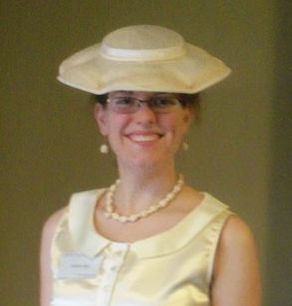DEFINITION OF BONNET When talking about womenswear, a bonnet is a woman's head-dress which has a brim of some kind and which ties under the chin. The tying under the chin may be the original distinctive element, since its etymology shows it "akin to Old Saxon gibund bundle, Old English bindan to bind". It is stiffer and more structured than a coif, which often ties on but is a close-fitting and entirely soft garment. It's different from a hat, which can have a brim, and may tie under the chin, but has an entirely different attitude. BONNET ATTITUDE? Really, it's the attitude which is hardest to quantify. I read once that women's headgear in Western fashion tells the story of their role in the public realm: when they wear hats, they're more empowered in the world, but when they wear bonnets they're relegated to a narrower, more domestic sphere. Bonnets have a demure look about them, a meekness. But why? They can be trimmed elaborately with lace and flowers and feathers, so they could be as extravagant as any other article. Yet they are still super-feminine. Is it because they cannot be worn at a jaunty angle? Is it because they are more shielding to the wearing, but potentially more blinding? In the book He Knew He was Right, long-suffering and much maligned Emily Trevalyan suffers greatly due to her husband's crazy suspicions and behavior. Through all the harshness, insinuations and social ostracism, she maintains a dignified brightness, unwilling to be beaten down. But at the very end, when her husband is dying and she's decided that he's insane and deserves her pity, she loses the will to be her own person. "It was not till this point had come in her sad life that her dress became always black and sombre, that a veil habitually covered her face, that a bonnet took the place of the jaunty hat that she had worn, and that the prettinesses of her life were lain aside," writes Trollope. The bonnet is shorthand for a truncated expression of self, a devotion to service. I tend to apply the "I know it when I see it" test to identifying bonnets. Here are some examples:
A COY PLAY WITH A BONNET  There's a scene in the film Gone With the Wind where Rhett brings coquettish Scarlett a new bonnet as a gift. Being a little fashionista, she knows exactly how it's meant to be worn, but plays the ingenue and puts it on upside-down, with the back ruffle instead acting as a floppy brim. Her ploy succeeds wonderfully: Rhett has to fix it for her, and she gets his attention, his hands on her, and his patronizing regard. She comes across as the innocent and helpless female, needing his help to don her bonnet, needing his manliness to make a woman of her. (Not that he's fooled... you can't play a player!) But Scarlett only pantomimes submissive femininity: her turning the bonnet upside-down is symbolic of what she does to gender roles generally: she's more of a hat person that a bonnet person! Throughout the film, Scarlett is always most herself in a hat.
1 Comment
The Sister
8/6/2021 10:05:46 am
Oh my sister, how insightful you were in the paragraph about Scarlett O'Hara. I enjoy reading your blog! This post was interesting, and I find myself in the same "I know it when I see it" boat. Very fun all the same!
Reply
Leave a Reply. |
Karen Roy
Quilting, dressmaking, and history plied with the needle... Sites I EnjoyThe Quilt Index Categories
All
Archives
March 2024
|







 RSS Feed
RSS Feed